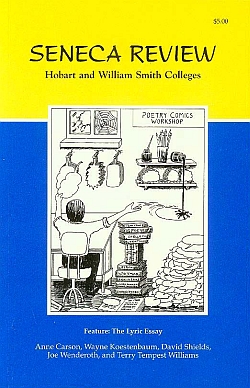The LyricEssay

With its Fall 1997 issue, Seneca Review began to publish what we've chosen to call the lyric essay. The recent burgeoning of creative nonfiction and the personal essay has yielded a fascinating sub-genre that straddles the essay and the lyric poem. These "poetic essays" or "essayistic poems" give primacy to artfulness over the conveying of information. They forsake narrative line, discursive logic, and the art of persuasion in favor of idiosyncratic meditation.
The lyric essay partakes of the poem in its density and shapeliness, its distillation of ideas and musicality of language. It partakes of the essay in its weight, in its overt desire to engage with facts, melding its allegiance to the actual with its passion for imaginative form.
The lyric essay does not expound. It may merely mention. As Helen Vendler says of the lyric poem, "It depends on gaps. . . . It is suggestive rather than exhaustive." It might move by association, leaping from one path of thought to another by way of imagery or connotation, advancing by juxtaposition or sidewinding poetic logic. Generally it is short, concise and punchy like a prose poem. But it may meander, making use of other genres when they serve its purpose: recombinant, it samples the techniques of fiction, drama, journalism, song, and film.
Given its genre mingling, the lyric essay often accretes by fragments, taking shape mosaically - its import visible only when one stands back and sees it whole. The stories it tells may be no more than metaphors. Or, storyless, it may spiral in on itself, circling the core of a single image or idea, without climax, without a paraphrasable theme. The lyric essay stalks its subject like quarry but is never content to merely explain or confess. It elucidates through the dance of its own delving.
Loyal to that original sense of essay as a test or a quest, an attempt at making sense, the lyric essay sets off on an uncharted course through interlocking webs of idea, circumstance, and language - a pursuit with no foreknown conclusion, an arrival that might still leave the writer questioning. While it is ruminative, it leaves pieces of experience undigested and tacit, inviting the reader's participatory interpretation. Its voice, spoken from a privacy that we overhear and enter, has the intimacy we have come to expect in the personal essay. Yet in the lyric essay the voice is often more reticent, almost coy, aware of the compliment it pays the reader by dint of understatement.
What has pushed the essay so close to poetry? Perhaps we're drawn to the lyric now because it seems less possible (and rewarding) to approach the world through the front door, through the myth of objectivity. The life span of a fact is shrinking; similitude often seems more revealing than verisimilitude. We turn to the artist to reconcoct meaning from the bombardments of experience, to shock, thrill, still the racket, and tether our attention.
We turn to the lyric essay - with its malleability, ingenuity, immediacy, complexity, and use of poetic language - to give us a fresh way to make music of the world. But we must be willing to go out on an artistic limb with these writers, keep our balance on their sometimes vertiginous byways. Anne Carson, in her essay on the lyric, "Why Did I Awake Lonely Among the Sleepers" (Published in Seneca Review Vol. XXVII, no. 2) quotes Paul Celan. What he says of the poem could well be said of the lyric essay:
The poem holds its ground on its own margin.... The poem is lonely. It is lonely and en route. Its author stays with it.
If the reader is willing to walk those margins, there are new worlds to be found.
--Deborah Tall, Editor and John D'Agata, Associate Editor for Lyric Essays
